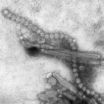(Press-News.org) Johns Hopkins scientists have shown a strong association between tobacco use or exposure and infection with oral human papillomavirus type 16 (HPV16), the sexually transmitted virus responsible for mouth and throat cancers worldwide. The numbers of such cancers have increased 225 percent in the United States over the past two decades.
HPV16 is found in 80 percent of cancers located in the back of the throat and is transmitted through oral sex. "The practice of oral sex is common, but this cancer is rare. So there must be cofactors in the process that explain why some people develop persistent HPV16 infections and HPV-positive oropharyngeal cancers when most other people don't," says Gypsyamber D'Souza, Ph.D., M.S., M.P.H., an associate professor of epidemiology at the Johns Hopkins Bloomberg School of Public Health and Johns Hopkins Kimmel Cancer Center.
The research team found that HPV16 infection is more common among people who have recently used or been exposed to tobacco, independent of their sexual behavior, according to authors of the new study published in the Oct. 7 issue of JAMA.
"It appears that tobacco exposure increases the likelihood of having oral HPV16 infection, and although we do not yet know why, we suspect that the virus may not be cleared from the body as easily in people who use tobacco," says D'Souza.
But the researchers caution that although the study shows an independent relationship between tobacco and HPV16 infection, they cannot fully rule out the possibility that people who use more tobacco might also have more oral sex, and therefore have a higher risk of HPV16 infection.
Previous studies have shown an association between oral HPV16 infection and cigarette use. The new study takes this reported association a step further by looking at oral HPV16 infection among people who tested positive for the presence of tobacco-linked chemicals in their blood or urine, which can come from any tobacco source – even secondhand smoke, says Carole Fakhry, M.D., M.P.H., an assistant professor of otolaryngology-head and neck surgery at the Johns Hopkins University School of Medicine.
While the current study links tobacco use and exposure as a risk factor for oral HPV16 infection, the researchers emphasize that smoking or other forms of tobacco use do not directly cause HPV16 infection, and that nonsmokers can still get HPV16 infections.
The study's 6,887 participants were drawn from the National Health and Nutrition Examination Survey, which comprises a representative sample of the U.S. population. They included 2,012 who were current tobacco users at the time of the study and 63 who were infected with HPV16.
The virus was detected by a 30-second oral rinse and gargle that collected mouth and throat cells. The participants described their tobacco use in a survey and also had their blood and urine tested for two tobacco-related chemicals, cotinine and NNAL (4-(methylnitrosamino)-1-(3-pyridyl)-1-butanol).
People with higher levels of the tobacco-related biomarkers in their blood and urine were more likely to have oral HPV16 DNA, compared with those who had no detectable levels of the compounds, says Fakhry. "We found that increasing levels of tobacco exposure were associated with higher odds of oral HPV16 prevalence," she adds.
Each increase in the blood level of cotinine, equivalent to three cigarettes per day, increased the odds of HPV16 prevalence by 31 percent. Each rising level of NNAL detected in urine, the equivalent of four daily cigarettes, increased the odds of HPV16 prevalence by 68 percent. This so-called dose-response curve is considered to be scientifically strong evidence of association between two events.
"These results may provide an additional reason for smoking cessation and suggest that even modest amounts of tobacco use are associated with higher oral HPV prevalence," says Fakhry.
INFORMATION:
D'Souza and Fakhry were joined by Maura L. Gillison of The Ohio State University on the JAMA study. Timothy S. McNeel, B.A., of Information Management Services Inc. assisted with and received compensation for statistical analyses.
Funding for the study was provided by the National Institute of Dental and Craniofacial Research (P50DE019032, R01DE021395, R01DE023175), the Milton J. Dance Jr. Head and Neck Center at Greater Baltimore Medical Center, and Merck.
Johns Hopkins Medicine (JHM), headquartered in Baltimore, Maryland, is a $7 billion integrated global health enterprise and one of the leading academic health care systems in the United States. JHM unites physicians and scientists of the Johns Hopkins University School of Medicine with the organizations, health professionals and facilities of The Johns Hopkins Hospital and Health System. JHM's vision, "Together, we will deliver the promise of medicine," is supported by its mission to improve the health of the community and the world by setting the standard of excellence in medical education, research and clinical care. Diverse and inclusive, JHM educates medical students, scientists, health care professionals and the public; conducts biomedical research; and provides patient-centered medicine to prevent, diagnose and treat human illness. JHM operates six academic and community hospitals, four suburban health care and surgery centers, and more than 35 Johns Hopkins Community Physicians sites. The Johns Hopkins Hospital, opened in 1889, has been ranked number one in the nation by U.S. News & World Report for 22 years of the survey's 25 year history, most recently in 2013. For more information about Johns Hopkins Medicine, its research, education and clinical programs, and for the latest health, science and research news, visit http://www.hopkinsmedicine.org.
Media Contacts:
Vanessa Wasta, 410-614-2916, wasta@jhmi.edu
Amy Mone, 410-614-2914, amone@jhmi.edu
ANN ARBOR, Mich. — A decade ago, America's health care community took on heart attacks with gusto, harnessing the power of research and data to make sure that every patient got the best possible care.
It worked: Death rates for heart attack have dropped. The same has happened with heart failure and pneumonia. Now, say a pair of University of Michigan Medical School experts, it's time to do the same for sepsis.
Sepsis may not have the same name recognition as heart attacks -- but it now affects more hospital patients, and leads to more hospital costs, than any ...
An experimental vaccine to protect people against H7N9 avian influenza prompted immune responses in 59 percent of volunteers who received two injections at the lowest dosage tested, but only if the vaccine was mixed with adjuvant—a substance that boosts the body's response to vaccination. Without adjuvant, immune responses produced by the investigational vaccine were minimal regardless of vaccine dosage, according to findings from a clinical trial sponsored by the National Institute of Allergy and Infectious Diseases (NIAID), part of the National Institutes of Health.
The ...
A large, NIH-sponsored clinical trial of an experimental H7N9 avian influenza vaccine found an immune response that was believed to be protective in 59 percent of study participants who received two injections of the inactivated vaccine at the lowest dosage tested when mixed with an adjuvant – a component that boosts the body's immune response and enhances the effectiveness of inactivated influenza vaccines.
Participants who received a vaccine without the adjuvant had a minimal immune response.
The results are published in the Journal of the American Medical ...
VIDEO:
This video shows the sole of a shoe as it appears from different perspectives in rendering software. The shoe was placed upside down on an optical table (seen as flat...
Click here for more information.
Researchers at the National Institute of Standards and Technology (NIST) have demonstrated a laser-based imaging system that creates high-definition 3D maps of surfaces from as far away as 10.5 meters.* The method may be useful in diverse fields, including precision machining ...
(SALT LAKE CITY)—University of Utah biochemists have reported a new drug discovery tool against the Ebola virus. According to a study published in this week's online edition of Protein Science, they have produced a molecule, known as a peptide mimic, that displays a functionally critical region of the virus that is universally conserved in all known species of Ebola. This new tool can be used as a drug target in the discovery of anti-Ebola agents that are effective against all known strains and likely future strains.
The University of Utah (U of U) work, which was ...
The link between low average glucose blood levels and greater risk for severe hypoglycemia and hypoglycemic coma substantially declined between 1995 and 2012 in young Germans and Austrians with type 1 diabetes, according to a study published by Beate Karges and colleagues from the RWTH Aachen University, Germany in this week's PLOS Medicine.
The researchers obtained measurements of average blood glucose levels (measured as HbA1c) and the incidents of severe hypoglycemia and hypoglycemic coma from 37,539 children and young adults with type 1 diabetes between 1995 and 2012 ...
Treatment with dimercaptosuccinic acid (DMSA), an oral chelation agent, was linked to reductions in the amount of lead in blood in young children in Zamfara State, Nigeria following environmental lead contamination, according to a study by Jane Greig and colleagues from Médecins Sans Frontières (MSF) published in this week's PLOS Medicine.
The researchers report findings from an MSF program initiated in May 2010 to reduce lead poisoning in children following widespread environmental lead contamination due to gold mining in Zamfara State, Nigeria, leading to ...
A fundamental question in neurobiology is how animals, including humans, make decisions. A new study publishing in the open access journal PLOS Biology on October 7 reveals how fruit fly females make a very important decision: to either accept or reject male courtship. This decision appears to be generated by a very small number of excitatory neurons that use acetylcholine as their neurotransmitter located in three brain regions. This study provides the framework to understand how decisions are generated and suggests that a decision is reached because that option is literally ...
Researchers at the University of California, San Diego School of Medicine have, for the first time, clearly defined the epidemiology of gastrointestinal stromal tumors (GIST), which occur primarily in the lining of the stomach and small intestine. One key finding: Patients of Asian descent, who have not previously been identified as an at-risk population, are 1.5 times more likely than other patient groups to be diagnosed with this type of tumor. Results of the study were published this week in Cancer Epidemiology, Biomarkers & Prevention, a journal of the American Association ...
WASHINGTON (Oct. 7, 2014) — Nearly 20 percent of Americans have a disability, yet only 25 percent of medical schools include in their curricula caring for people with disabilities. Numerous reports have documented that people with disabilities have poorer health and receive inferior care.
In a Narrative Matters essay published in Health Affairs, Leana Wen, M.D., director of patient-centered care research and assistant professor of emergency medicine at the George Washington University School of Medicine and Health Sciences, shares her own experiences to highlight ...


